

Sign up for Mutt Mail
Share this post
It’s that time of the summer break when kids are complaining about being bored at home and parents are tired of nagging about screen time. The TurfMutt Foundation’s spokesdog Mo-Mo reminds us that enjoying time in the parks and yards nearby is good for us and for the planet.
Mo-Mo knows a thing or two about yards – and the boundless energy that many children need to expend outdoors. Spending time in the yard can help your children de-stress, widen their play area, and build up knowledge in science and math.
Mo-Mo offers these tips to help make the most of your yard during summer break.
Tip #1: Notice the different kinds of plants in your yard. Take kids around the outside of your home. Encourage them to take notes and sketch what they see. How is the landscape changing this time of year? What animals or birds might be nesting in or feeding on plants in the yard? What makes your yard unique from the others in the area? Ask your kids to draw a picture of the living (plants, trees, grass) and the non-living (patios, grills) parts of your landscape.
Tip #2: Learn about the world beneath little feet. Explain that one of the benefits of plant-filled green spaces is that they provide habitats, or natural homes, for many different creatures. Look for birds, bees and other creatures that have made both urban and suburban neighborhoods their home. Use a magnifying glass to help your child explore what lives in the grass or is resting on shrubs and trees.
Tip #3: Map out the living landscapes in your neighborhood. Go on a living landscape hunt. Walk around your neighborhood with your child and sketch the living landscapes, creating a map with symbols for trees, bushes, flowers and grass. You can also add markers for animal or insect habitats, or water sources.
Tip #4: Make a nature journal. Get some paper or a notebook and keep a record of when your family is outside and what you do when you are there. It can be as simple as jotting down the date and the activity you did outside, or as detailed as adding sketches of plants or animals observed, and more. Review the journal regularly to track how much time you spent outside.
Tip #5: Put the right plant in the right place. If you’ve decided to add some new plants to your yard as a family activity, check the USDA Plant Hardiness Zone Map to find out what plants are best for where you live. Use a mix of native and adaptive plants and place them where they will thrive – a teachable moment for children!
Tip #6: Visit TurfMutt.com to play games and read digital storybooks for free to learn more. The website for the TurfMutt environmental education and stewardship program for grades K-8 offers home-based activities, digital storybooks, lesson plans for families and teachers, and more.
To access the TurfMutt activities and learn more, go to TurfMutt.com.
Sign Up For Mutt Mail 💌
Mutt Mulligan’s monthly e-newsletter is loaded with tips on outdoor living, enjoying green spaces and resources for teachers and families, as well as news from the TurfMutt Foundation.

Get the latest backyarding tips straight from Mutt Mulligan!



